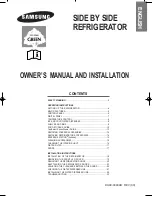
21
Tips for saving energy
Install the appliance in a dry, well
ventilated room; The appliance should
not be installed in direct sunlight or near
a heat source.
Allow warm food and drinks to cool
down before placing in the appliance.
Do not block the ventilation openings in
the appliance.
Thaw frozen food in the refrigerator
compartment.
Cleaning the appliance
Precautions for internal
and external cleaning of the
refrigerator.
Switch off the mains plug before
cleaning.
Be careful the rinsing water must not
run into the light.
Clean the appliance with a soft cloth,
lukewarm water and a little pH neutral
washing-up liquid.
Wipe the door seal with clear water only
and then wipe dry thoroughly.
Clean the collection tray and drainage
hole frequently to make sure the
condensation runs out smoothly.
Do not use abrasive, chloride or acidic
cleaning agents or solvents.
Keep plastic parts and the door seal
free of oil and grease. Otherwise, parts
and door seal will become porous.
Attention
The temperature rise of the frozen
food may shorten the shelf life during
maintenance or cleaning.
Cleaning and maintenance
Open the appliance as briefly as
possible.
Do not block the temperature sensors
and avoid contact between food and
sensor.
Miscellaneous
If a power failure occurs
Reduce the frequency of appliance door
opening; avoid placing new fresh food
inside (to prevent the temperature rising
faster).
If the power suspension is noticed,
select super cooling and super freezing
functions to keep in a low temperatures.
Switching off the appliance
If disconnecting the appliance is
necessary, switch off the appliance and
pull out mains plug.
If you do not use the appliance for
a prolonged period: switch off the
appliance, clean the appliance and
leave the appliance door open.
Do not shut down the appliance under
normal conditions, this may affect the
service life of the appliance.
Attention
If you decide to stop using the
appliance, no food should be stored
in the refrigerator.
















































